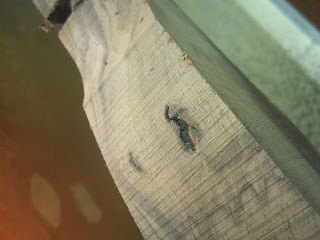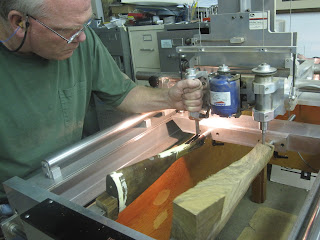I worked for D’Arcy while finishing up school at Utah State
University. At the time I had a Model 70
classic 30-06. We began doing some
improvements to it, adding the Legend Stock, when I asked D’Arcy about adding
his magazine box and follower. He said
if we were going to do that we might as well make it into a full Legend
Rifle. Who could turn that down?
I’d become a fan of the 200 grain Nosler partition and
decided the .300 Winchester Magnum would be a good platform to launch it
from. One of my goals was one rifle and
one load that I could hunt almost anything with.
I spent much of my time in D’Arcy’s shop polishing metal
work. Polishing is tedious work that
requires patience, attention to detail, and a commitment to do a good job. It probably isn’t considered a glorious job,
but good polishing is critical for the looks and function of the rifle. It also taught me how to spot and feel the
tiniest imperfections, because if I didn’t catch them D’Arcy would and he’d
just send me back to my bench. My
project got thrown into the mix just like any of the others. So along with the pride of owning a D’Arcy
Echols & Company Legend I enjoy hunting with a rifle I had a hand in
building.
My rifle was finished just before I moved to Wyoming. I put a Leupold M8 6x36 on it and started
hunting it. During a guiding season in
NW Wyoming I put a 1-4x Leupold on it for use as a bear gun. When I re-mounted the 6x I didn’t have to
touch the scope’s adjustments, it was still dead on. After 8 years of use it’s continues to be a
confidence inspiring rifle.
In 2008 I killed what may be my best trophy, a 365” bull elk
taken on the HD High Island Ranch where I live.
I first spotted the bull while looking over some young raghorns. He had just come out of the tree line above a
steep hill. Once I got him in my glasses
I knew he was big, his brow tines and whale tail just jumped out at me. I literally ran down the hill I was on,
headed towards a small finger ridge where I hoped the bull would be in range. Once I got there I threw myself on the ground
and ranged him at 328 yards. I shot him
twice as fast as I could and down he went.
The rifle has also taken several mule deer, a whitetail, and
quite a few more elk as well. It’s a
pleasure to hunt with a rifle that I know inside and out and know will work
every time.
Bart Stam














